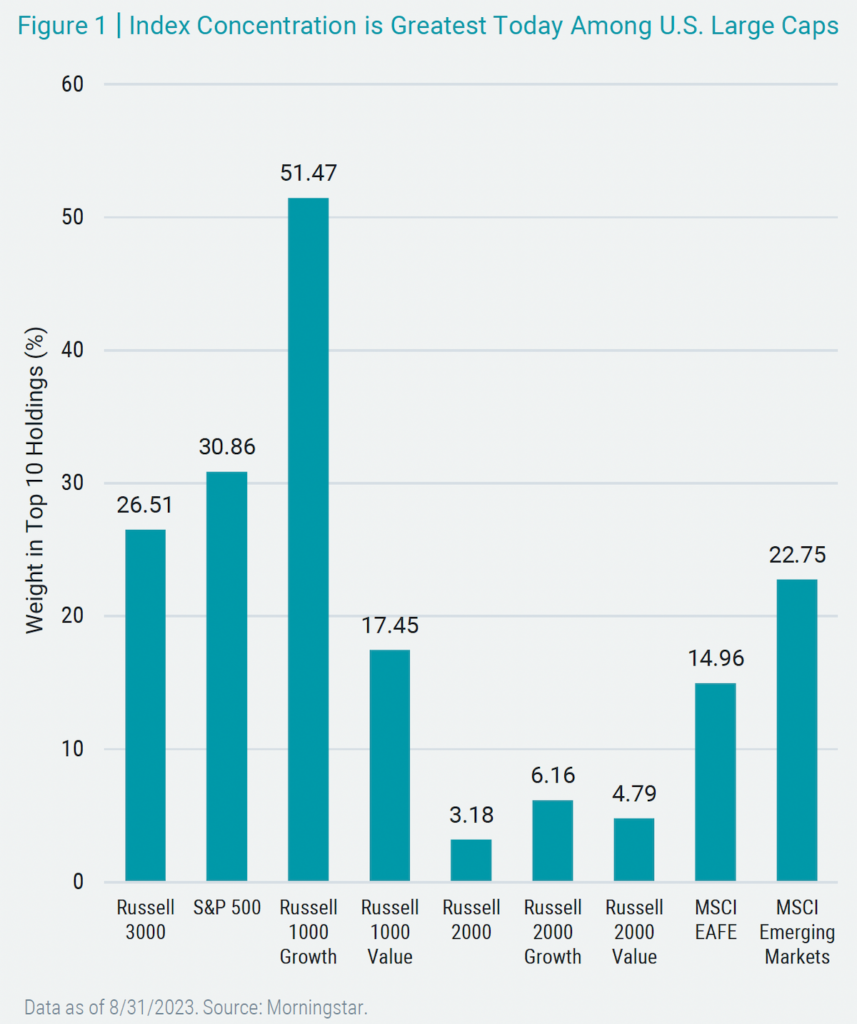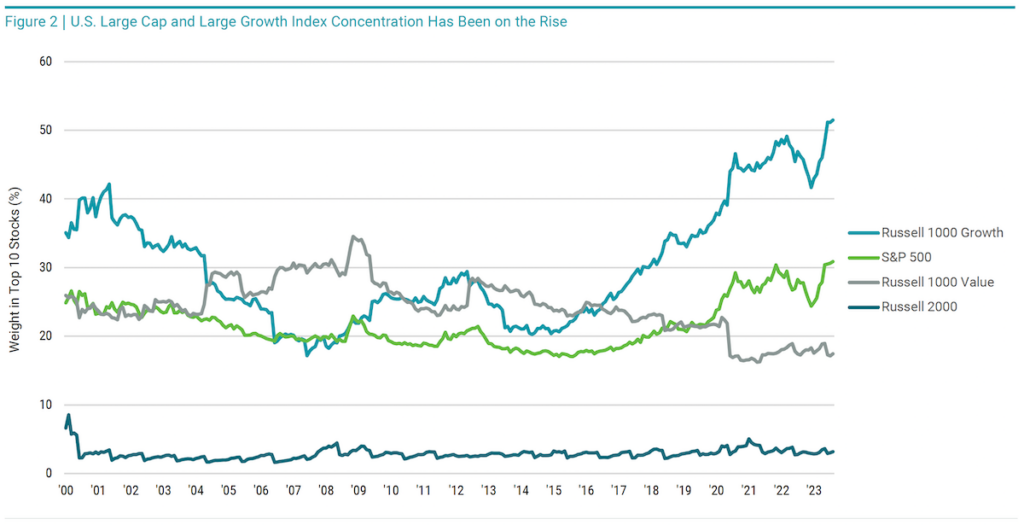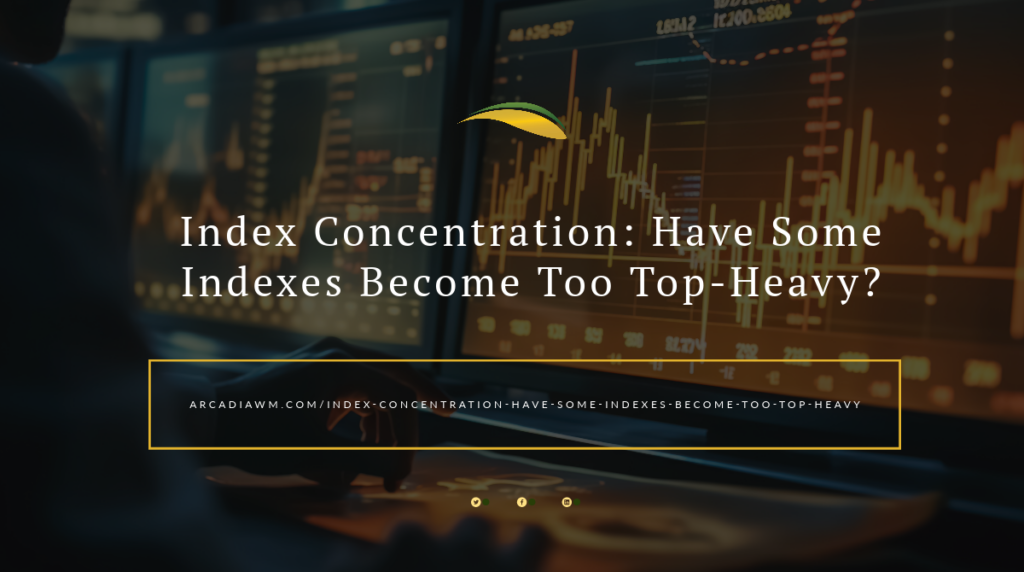Market indexes designed to represent total stock markets or broad subsets of a market are generally known to offer investors high levels of diversification. Many well-known indices, like the S&P 500® Index and Russell 3000® Index, hold hundreds or thousands of companies. Yet, by some measures, many major indexes appear more concentrated today than ever.
 Figure 1 presents the weight of the top 10 stocks in several commonly followed indexes representing U.S. and non-U.S. stock markets. For the U.S., asset class indexes representing market subsets like value and growth stocks are also shown.
Figure 1 presents the weight of the top 10 stocks in several commonly followed indexes representing U.S. and non-U.S. stock markets. For the U.S., asset class indexes representing market subsets like value and growth stocks are also shown.
Based on the top 10 holdings, the concentration level is most significant among U.S. large-cap stocks, particularly U.S. large-cap growth stocks. The Russell 3000, which contains U.S. large-and small-cap stocks, has more than 26% in its top 10 holdings, while the S&P 500, which includes roughly the largest 500 U.S. companies, has nearly 31%.
But the result that stands out the most comes from the Russell 1000®Growth Index, which represents U.S. large-cap growth stocks. This index holds a whopping 51.5% in only 10 companies! This starkly contrasts with only 17.4% in the top 10 names of the Russell 1000®Value Index, representing U.S. large-cap value stocks.
Figure 2 highlights how top 10 holdings weight has evolved for these U.S. large-cap indexes. We include U.S. small-caps (Russell 2000®Index) for reference. While top 10 stock concentration has historically been higher among large-caps than small-caps, it’s clear that top 10 weight has increased meaningfully over time for the S&P 500 and Russell 1000 Growth, standing today at their highest levels since the start of the century. Russell 1000 Value is near its lowest observed level.
Figure 3 provides historical context for each index from Figure 1, showing the current top 10 weight versus its averages since January 2000, along with the maximum and minimum levels over the period. While indexes holding U.S. large growth stocks (Russell 3000, S&P 500, Russell 1000 Growth) are currently at their historical highs, all other indexes are near or below their historical averages and well below their historical highs.
We believe the implications of these observations for diversification and risk are clear. As a small subset of companies make up a greater portion of a portfolio, these companies’ returns will have a greater impact on overall portfolio results —whether good or bad. Further, stocks that run up in price to increase in size often come with higher valuations (the price of a stock relative to fundamentals like its earnings or book value), which may mean holding greater weight in stocks with lower expected returns going forward.

Sound familiar? This has been a widely talked about story in 2023 as many large U.S. companies (primarily growth stocks) have only gotten larger on solid performance but, in many cases, without commensurate increases in their earnings or book values.
Equal-weighted indexes are one approach that attempts to address concerns over indexes becoming too top-heavy or concentrated in companies with high valuations. These indexes take all companies in the market or a subset of the market and hold them at the exact same weight rather than based on market capitalization (a company’s price times its number of shares outstanding) as most well-known market indexes.
What do you get when equally weighting all companies in the market? Versus a market-cap-weighted approach, the result is less weight in large companies and more weight in smaller firms. In other words, this produces a tilt toward companies with small and mid-sized market capitalizations and away from the largest companies.
This approach also tends to tilt toward companies with lower prices to fundamentals, commonly known as value companies. But treating all companies the same, ignoring prices and fundamentals, isn’t likely the best way to achieve these tilts and address concerns with the current market concentration “problem.” Under this approach, a tiny micro-cap company with negative earnings and a weak balance sheet would receive the same weight as the largest company in the market.
Ignoring prices is never a good idea when buying anything. The same applies to investments. Considering company prices is essential since they are the best and fastest way to incorporate news in a portfolio. For example, bad news for a company will push down its price, but an equally weighted portfolio will completely ignore this information.
But considering only prices and ignoring fundamentals, as market-cap-weighted approaches do, also has limitations. The result can be holding more weight in companies whose prices have risen due to overly optimistic earnings growth expectations.
These approaches represent two extremes that can be improved upon using prices and fundamentals when considering how to weigh companies in a portfolio. A security’s expected return depends on its price relative to its balance sheet and expected earnings, so including this information when deciding how to weigh securities is expected to improve outcomes.
In our view, the takeaway from the data shown isn’t that the market becomes a bad investment because of a subset of large companies becoming a larger portion of the overall market. Naïve approaches that claim to offer a better alternative by deviating wildly from the market may warrant scrutiny and probably some healthy skepticism.
We believe well-constructed portfolios should be designed to balance expected returns and risk carefully, considering companies’ prices and financials while targeting broad diversification across companies, sectors, and markets. Maintaining a clear understanding of any deviations from the market and the expected benefits and risks of doing so is critically important.
Download a PDF of this article
Download the September 2023 Market Review
This article was provided by Avantis Investors and we have been given permission to share this information with our clients and potential clients.







